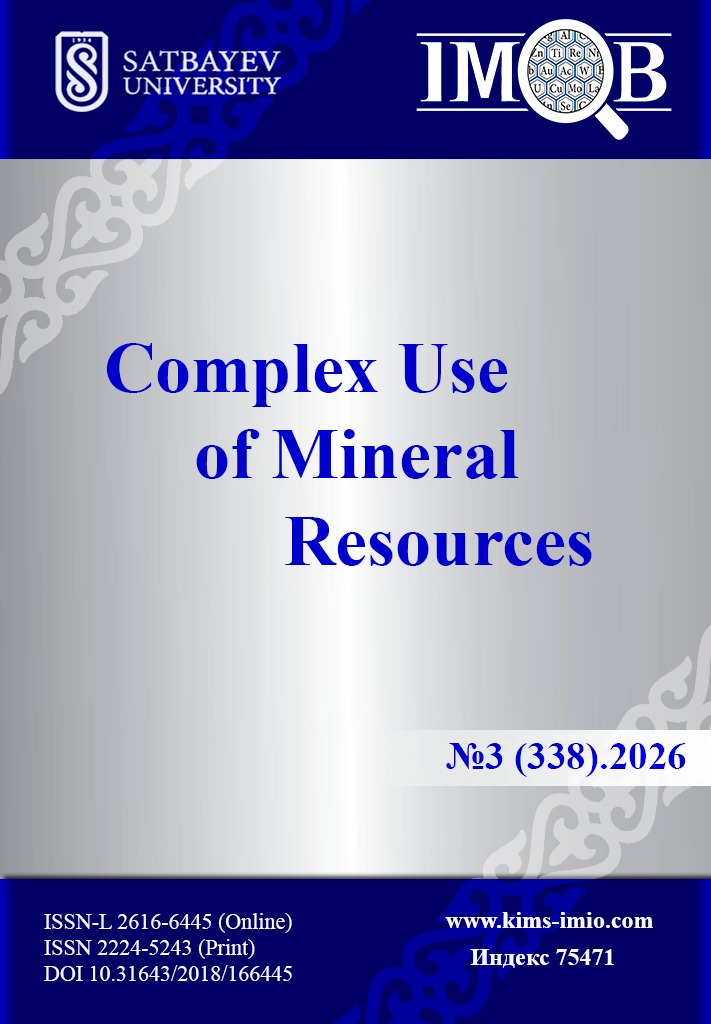Epoxy Resin Development for Anticorrosion Coatings
DOI:
https://doi.org/10.31643/2026/6445.24Keywords:
Epoxy, hardener, mechanical, corrosion, additives.Abstract
In this study, a high molecular weight epoxy resin (ELM-NG 900Z) based on diglycidyl ether of bisphenol A was cured with different types of hardeners to examine their impact on the physical and mechanical properties of the epoxy resin. The hardeners used were G-5022X70 (140-170 mg KOH/g), G-A0533 (310-350 mg KOH/g), and G-0930 (280-320 mg KOH/g). The results indicated that the hardener G-A0533 provided the best mechanical properties for the epoxy resin compared to other hardeners. Furthermore, various additives including silica fume, talc, barium sulfate, ferric oxide, and pigments were mixed with the epoxy resin in the presence of the hardener G-A0533 to enhance its mechanical properties. It was observed that the addition of 3% silica fume, 10% ferric oxide, and 3% inorganic pigments improved the mechanical properties, while the addition of 5% talc decreased most mechanical properties and only increased hardness. The incorporation of barium sulfate into the epoxy resin enhanced adhesion and flexural strength but decreased tensile strength and hardness. The inclusion of organic pigment had no significant effect on the mechanical properties of the epoxy resin. This enhancement in mechanical properties is attributed to the type of hardener used as well as the types and amounts of additives mixed with the epoxy resin.
Downloads
References
Bhavith K, Prashanth Pai M, Sudheer M, Ramachandra CG, Maruthi Prashanth BH, Kiran Kumar B. The Effect of Metal Filler on the Mechanical Performance of Epoxy Resin Composites. Engineering Proceedings. 2023; 59(1):200. https://doi.org/10.18517/ijaseit.7.4.2480
Najat J S, Adnan A A, Manal A T, Mariam E. A study on mechanical properties of epoxy resin cured at constant curing time and temperature with different hardeners. Engg. & Tech. Journal. 2011; 29:1804. https://doi.org/10.30684/etj.29.9.15
Sudheer M, Subbaya KM, Jawali D, Bhat T. Mechanical Properties of Potasium Titanate Whisker Reinforced Epoxy Resin Composites. J. Miner. Mater. Charact. Eng. 2012; 11:193. https://doi.org/10.4236/jmmce.2012.112016
Dheeraj KG, Gujjala R, Syam PP, Ojha S. Enhanced mechanical properties of glass fibre epoxy composites by 2D exfoliated graphene oxide filler. Ceramics International. 2021; 47(24):34860-34868. https://doi.org/10.1016/j.ceramint.2021.09.027
Kowshik S, Shettar M, Rangaswamy N, Chate G, Somdee P. Effect of nanoclay on mechanical, flammability, and water absorption properties of glass fiber-epoxy composite. Cogent Eng. 2022; 9:2069070. https://10.1080/23311916.2022.2069070
Ramkumar Y, Mayank S, Deepika S, Seul-Yi L, Soo-Jin P. The role of fillers to enhance the mechanical, thermal, and wear characteristics of polymer composite materials: A review. Composites Part A: Applied Science and Manufacturing. 2023; 175:107775. https://10.1016/j.compositesa.2023.107775
Baroncini E, Kumar S, Palmese G, and Stanzione J. Recent Advances in Bio‐based Epoxy Resins and Bio‐based Epoxy Curing Agents. Journal of Applied Polymer Science. 2016; 44103:1. https://doi.org/10.1002/app.44103
Allahverdi A, Ehsani M, Janpour H, Ahmadi S. The effect of nanosilica on mechanical, thermal and morphological properties of epoxy coating. Progress in Organic Coatings. 2012; 75(4):543-548. https://doi.org/10.1016/j.porgcoat.2012.05.013
Avilés M, Perugachi R. Rigail-Cedeño A. Bio-Based Silica Reinforced Aliphatic Bio-Epoxy Composites. Global Partnerships for Development and Engineering Education. Proceedings of the 15th LACCEI International Multi-Conference for Engineering, Education and Technology. 2017; 1. http://dx.doi.org/10.18687/LACCEI2017.1.1.299
Jin F-L, Park S-J. Thermal properties of epoxy resin/filler hybrid composites. Polymer Degradation and Stability. 2012; 97(11):2148-2153. https://doi.org/10.1016/j.polymdegradstab.2012.08.015
Negim E, Shalash M, Al Azzam KM, Sagatbekovna MZ, Kairatovna BA, Konstantinovich AT, Adlikhanovna NA, Ermekovna KA, Ravindran B. Synthesis, Characterization, and Application of Polyurethane-Acrylic Hybrids as Anticorrosion Coatings. International Journal of Technology. 2024;15(6):009-2023. https://doi.org/10.14716/ijtech.v15i6.7044
Rigail-Cedeño A, Schmidt DF. Bio-based epoxy clay nanocomposites. AIP Conference Proceedings. 2017; 1914:030023. https://doi.org/10.1063/1.5016710
Sienkiewicz A, Czub P. Modification of Epoxy Compositions by the Application of Various Fillers of Natural Origin. Materials. 2023; 16(8):3149. https://doi.org/10.3390/ma16083149
Abd El-Ghaffar MA, Abdelwahab NA, Amany M Fekry, Sanad MA, Sabaa MW, Soliman SMA. Polyester-epoxy resin/conducting polymer/barium sulfate hybrid composite as a smart eco-friendly anti-corrosive powder coating. Progress in Organic Coatings. 2020; 144:105664. https://doi.org/10.1016/j.porgcoat.2020.105664
Neha KR, Sharif A. Synergistic effect of nanosize and irradiation on epoxy/conducting poly(o-phenyldiamine) nanospheres composite coatings: Synthesis, characterization and corrosion protective performance. Materials Chemistry and Physics. 2018; 204: 282-293. https://doi.org/10.1016/j.matchemphys.2017.10.044
Bekbayeva L, Negim E-S, Zhanibekov R, Sharipov R, Maldybayev G, Puzikova D, Kenzin N, Maridan A. Epoxy coatings for anticorrosion applications: a review. Kompleksnoe Ispolzovanie Mineralnogo Syra = Complex Use of Mineral Resources. 2026; 337(2): 35. https://doi.org/10.31643/2026/6445.15
Sally C. The Munsell Color System: A scientific compromise from the world of art. Studies in History and Philosophy of Science Part A. 2014; 47:26-41. https://doi.org/10.1016/j.shpsa.2014.03.004
Gatis V, Irina A, Yukako H, Ilvars I. Colour Extraction and Analysis Solution for Design of Cross-cultural Websites. Procedia Computer Science. 2015; 77:215-220. https://doi.org/10.1016/j.procs.2015.12.374
Dong WK, Ki B N, Sung CH. Influence of tungsten on the activity of a Mn/Ce/W/Ti catalyst for the selective catalytic reduction of NO with NH3 at low temperatures. Applied Catalysis A: General. 2015; 497:160-166. https://doi.org/10.1016/j.apcata.2015.01.013
Negim SM, Bahruddin S, Mahyuddin R, & Idiris MS. Effects of TDI and FA‐703 on physico‐mechanical properties of polyurethane dispersion. Journal of Applied Polymer Science. 2011; 121(1):8-13. https://doi.org/10.1002/app.33569
ISO 12058-1. International standard: Determination of viscosity using a falling-ball viscometer. 2018. ISO 12058-1:2018(E)
American Society for Testing and Materials (ASTM). ASTM D3359. Standard Test Methods for Rating Adhesion by Tap Test – 2001.
American Society for Testing and Materials (ASTM). ASTM D2794. Standard Test Methods for Resistance of Organic Coatings to The Effects of Rapid Deformation (Impact) – 2019.
American Society for Testing and Materials (ASTM). ASTM D1652. Standard Test Method for Epoxy Content of Epoxy Resins – 2019.
En, B., 1542. Products and systems for the protection and repair of concrete structures. Test methods Measurement of bond strength by pull-off – 1999.
Syrmanova K, Negim E, Kaldybekoekova J, Tuleuov AM. Epoxylitane compositions modification with using thermoplastic polyurethane. Oriental Journal of Chemistry. 2016; 32(1). http://dx.doi.org/10.13005/ojc/320101
Sabergaliyev M, Yeligbayeva G, Khassanov D, Muradova S, Orazalin Z, Ainakulova D, Sharipov R, & Negim E-S. Modified bitumen-polymer mastic to protect metal coatings from corrosion. Kompleksnoe Ispolzovanie Mineralnogo Syra = Complex Use of Mineral Resources. 2024; 331(4); 12. https://doi.org/10.31643/2024/6445.35
Downloads
Published
How to Cite
Issue
Section
License
Copyright (c) 2025 El-Sayed Negim, L. Bekbayeva, D.S. Puzikova, M.Zh. Zhurynov, A.N. Nefedov, G.M. Khussurova, N.A. Shadin, Jamal Khatib

This work is licensed under a Creative Commons Attribution 4.0 International License.


























